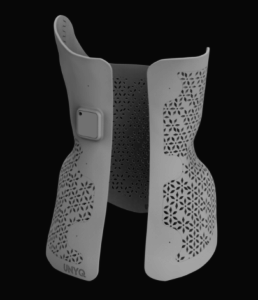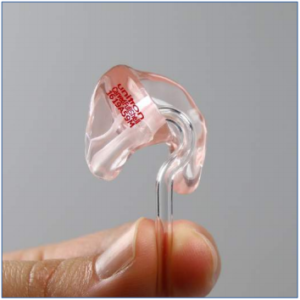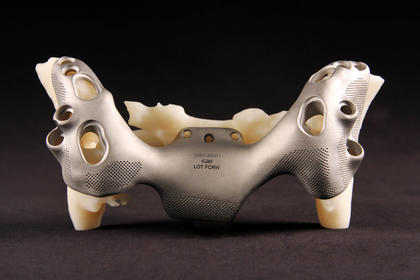3D4MD specializes in the creation of medical supplies using 3D printing on-site in remote areas. It doesn’t get much more remote than outer space, but there are plenty of locations on Earth that don’t have access to quality healthcare. Those locations are 3D4MD’s targets. Dr. Wong developed a solar-powered, mobile 3D printer that can be transported in a carry-on suitcase, so that it can be taken anywhere in the world and set up even in the most off-the-grid areas. In these areas, the 3D4MD team sets up a 3D printer and creates splints, medical models, assistive devices, and surgical tools wherever they’re needed.
3D4MD’s work is only one example of how 3D printing is changing the medical device industry. The benefits that 3D printing brings to remote areas are obvious – a solar-powered machine can be set up anywhere, without access to electricity, and used to instantly produce supplies that otherwise would have to be ordered from halfway across the world, requiring time and money that many of the people in these areas don’t have. It’s extremely cheap to produce a plastic splint with a 3D printer. But it’s not just remote areas that are benefiting from the technology.
 Not long ago, scoliosis braces were bulky, uncomfortable, and highly visible, and creating them was no picnic either, requiring plaster casts. But 3D printing has changed that, enabling the creation of lightweight, comfortable braces that fit snugly and can be created with no more than a quick scan of the body. Recently, WASPmedical inaugurated its Digital Orthopedic Laboratory, a lab equipped with a custom body scanner and two large-scale 3D printers for the creation of orthopaedic devices such as braces and splints.
Not long ago, scoliosis braces were bulky, uncomfortable, and highly visible, and creating them was no picnic either, requiring plaster casts. But 3D printing has changed that, enabling the creation of lightweight, comfortable braces that fit snugly and can be created with no more than a quick scan of the body. Recently, WASPmedical inaugurated its Digital Orthopedic Laboratory, a lab equipped with a custom body scanner and two large-scale 3D printers for the creation of orthopaedic devices such as braces and splints.
One of the keys to the importance of 3D printed medical devices is how easy it is to create patient-specific treatments and to do it inexpensively and with a minimum of discomfort for the patient. 3D Systems has been working with patient-specific implants for some time, 3D printing them for client companies such as K2M and EIT. In the past, implants were made only in a few different sizes, and frequently would not fit the patient perfectly, resulting in further pain, complications, and often revision surgery. 3D printing, however, is enabling medical professionals to create implants in the exact size and shape of the patient’s anatomy, meaning that surgeries are quicker and there’s less of a risk of complications or need for further surgery in the future.
Katie Weimer, Vice President of Medical Devices for 3D Systems, has been working with 3D printing and medicine for the majority of her career. She is an expert in the field of 3D printed medical devices, and sees patient-specific metal implants as a major factor driving the industry forward.
It’s easy to get over-enthusiastic and think that 3D printing will take over the medical device industry, but Weimer is more realistic, pointing out that the industry has been using many other forms of manufacturing for years, and that many of those methods are still perfectly reliable. She would like to see about a 15 to 20% adoption rate of 3D printing in the medical device industry, realistically.“We’re seeing the area of metals manufacturing, specifically for volume printing of medical devices…as a really hot area right now, where medical device companies are looking to 3D printing to print complex shapes much easier, for things like part consolidation, for things like integration of porous structures into these solid implants,” she told 3DPrint.com. “We’re able to really compete with traditional manufacturing in many areas to create a more cost-competitive solution for printing these types of implants while, at the same time, improving functionality and outcomes by doing some of these things like integration of porous and solid in one manufacturing step instead of two.”
“Even that sort of adoption would be really a paradigm shift in the industry,” she said.
 Speaking of paradigm shifts, Weimer also mentioned areas like hearing aid shells and clear dental aligners as areas where 3D printing is making some of the most impact. The hearing aid industry is one that genuinely has been taken over by 3D printing – 15 years ago, EnvisionTEC 3D printed hearing aid shells for Phonak, a Sonova brand, and the rest of the hearing aid industry rapidly followed suit. The technology allowed for the kind of custom fit and comfort that wasn’t possible before, not to mention enabling much faster production. As Weimer pointed out, patient-specific hearing aids can’t be mass-manufactured without 3D printing – it’s just not possible with any other kind of technology.
Speaking of paradigm shifts, Weimer also mentioned areas like hearing aid shells and clear dental aligners as areas where 3D printing is making some of the most impact. The hearing aid industry is one that genuinely has been taken over by 3D printing – 15 years ago, EnvisionTEC 3D printed hearing aid shells for Phonak, a Sonova brand, and the rest of the hearing aid industry rapidly followed suit. The technology allowed for the kind of custom fit and comfort that wasn’t possible before, not to mention enabling much faster production. As Weimer pointed out, patient-specific hearing aids can’t be mass-manufactured without 3D printing – it’s just not possible with any other kind of technology.
Volume production and patient-specific capabilities are among the most significant factors to consider when looking at the impact 3D printing has had on the medical device industry. No, 3D printing may never take over the industry completely, but it has changed it in immensely positive ways. Its effects on people range from a more comfortable hearing aid to a spinal implant that enables someone to walk. This is an industry that is still very young and growing rapidly, and it will continue to be a fascinating one to watch as it affects people all over the world.
Discuss this and other 3D printing topics at 3DPrintBoard.com or share your thoughts below.
Subscribe to Our Email Newsletter
Stay up-to-date on all the latest news from the 3D printing industry and receive information and offers from third party vendors.
You May Also Like
Precision at the Microscale: UK Researchers Advance Medical Devices with BMF’s 3D Printing Tech
University of Nottingham researchers are using Boston Micro Fabrication‘s (BMF) 3D printing technology to develop medical devices that improve compatibility with human tissue. Funded by a UK grant, this project...
GaeaStar and Verve Coffee Roasters Start Pilot Production of Sustainable 3D Printed Coffee Cups
Following a 2022 debut in Germany, GaeaStar, a startup based in San Francisco and Berlin, has begun US pilot production of its sustainable, disposable clay cups and bowls made with...
Meltio and Accufacture Unveil Robotic Metal 3D Printer Made in the US
Meltio has partnered with Michigan-based robotics firm Accufacture to introduce Alchemist 1, a robotic cell designed for wire-laser metal 3D printing made in the US. This new system represents a...
WASP Highlights Advances in Healthcare 3D Printing at Italy’s Exposanità 2024
WASP takes center stage at Italy’s leading healthcare expo, Exposanità 2024, demonstrating the transformative impact of its advanced 3D printing technologies on the medical sector. Known for its line of...


































